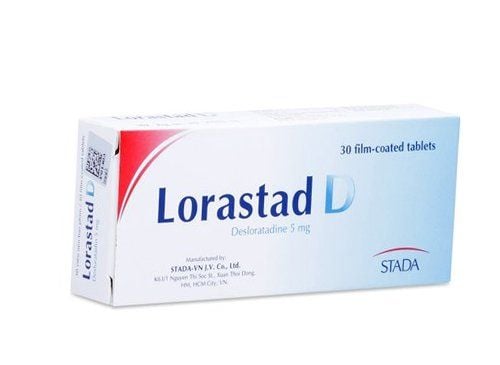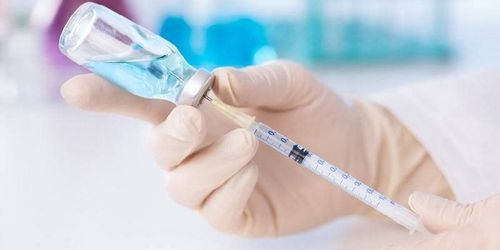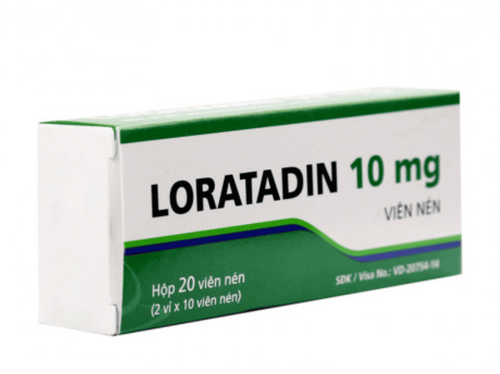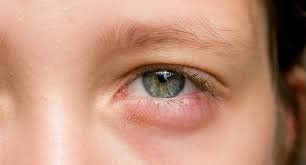This is an automatically translated article.
Lorastad has the main active ingredient, loratadine, a commonly used second generation H1 antihistamine. The article will provide readers with some general information about the drug Lorastad.
1. What is Lorastad?
Loratadine is a long-acting H1 antihistamine. Loratadine is rapidly absorbed from the gastrointestinal tract, food increases bioavailability by 40-48% and peak plasma concentrations are reached about 1 hour after dosing. Loratadine is metabolised mainly by the liver and the major metabolite, desloratadine, also has antihistamine activity. The mean half-lives of Loratadine and desloratadine were 8.4 and 28 hours, respectively. Loratadine and its metabolites may be excreted in human milk. The majority of the drug is excreted in the urine and faeces mainly as metabolites.2. What disease does Lorastad treat?
Lorastad is indicated for the relief of symptoms of allergies, including allergic rhinitis, conjunctivitis and urticaria.

Thuốc Lorastad là một trong các loại thuốc kháng histamin H1
3. What is the dose of the drug?
Lorastad is used orally with specific doses as follows:
Adults and children ≥ 12 years old: 10mg x 1 time / day.
Children from 2 to 12 years old:
If body weight > 30 kg: 10mg x 1 time/day; If body weight < 30 kg: 5mg x 1 time/day. Patients should note that the above dosage is for reference only. The specific dose will vary depending on the condition and severity of the disease. You should consult your doctor or medical staff to get the right dose. Do not use the drug in case of hypersensitivity or allergy to any ingredient of the drug, children under 2 years old.
4. What are the side effects of the drug?
When using Loratadine in a dose greater than 10mg daily, the following side effects may occur:
Incidence 1-10%:
Central nervous system: Headache, sedation, somnolence , fatigue, anxiety; Gastrointestinal: Abdominal pain, vomiting, diarrhea, dry mouth. Frequency not determined:
Dermatology: Skin rash ; Gastrointestinal: Gastritis, nausea; Hypersensitivity: Hypersensitivity reaction. Rate <1%:
Hair loss, depression, anaphylaxis, cough, dizziness, dry nose, liver failure, increased appetite, palpitations, convulsions, tachycardia, supraventricular tachycardia .

Thuốc Lorastad có thể gây tác dụng phụ như rụng tóc
5. What is the note when using Lorastad?
In addition to learning "what does Lorastad do", the notes when using it are also very important:
When taking loratadine, patients will be at risk of dry mouth (especially in the elderly) and increased risk of cavities. tooth . Therefore, patients need to keep their teeth clean while taking Loratadin; Renal and hepatic impairment: Use with caution in patients with renal and hepatic impairment; Sedatives: The effects of Loratadine may be increased when used with other sedatives or ethanol; Interactions with other drugs: Concomitant use of Loratadine and Cimetidine leads to increased plasma concentrations of Loratadine because Cimetidine inhibits the metabolism of Loratadine. Concomitant treatment with loratadine and ketoconazole may lead to a 3-fold increase in loratadine plasma concentrations due to inhibition of CYP3A4. Ideally, patients should inform their doctor about all medications they are taking for appropriate advice; Driving and using machines: In clinical trials evaluating the ability to drive in patients receiving Loratadine, this ability was not impaired. However, there have been a few rare cases of patients experiencing drowsiness and this may affect the ability to drive or use machines; Pregnancy: Guidelines for the use of antihistamines in the treatment of allergic rhinitis or urticaria during pregnancy are the same as in nonpregnant women. Loratadine can be used as needed. The lowest effective dose should be used to ensure safety. Lactation: When antihistamine therapy is required in nursing women, a 2nd generation antihistamine, such as Loratadine, is preferred.
6. What to do in case of Lorastad overdose?
When using Lorastad overdose, patients may experience symptoms including:
Adults: Drowsiness, headache, tachycardia; Children: Extrapyramidal signs and palpitations. Treatment:
Management of Loratadine overdose includes symptomatic and supportive treatment. In case of acute Loratadine overdose, gastric emptying should be performed by inducing vomiting. Oral administration of activated charcoal after induction of vomiting may be effective for blocking the absorption of Loratadine. If induction of vomiting is ineffective or contraindicated (eg, in comatose patients, convulsion), gastric lavage can be performed.
In summary, Loratadin is an H1 antihistamine used to reduce allergic symptoms in diseases such as allergic rhinitis, conjunctivitis, urticaria,... Patients should not self-medicate but need Consult your doctor or pharmacist before use.
Please dial HOTLINE for more information or register for an appointment HERE. Download MyVinmec app to make appointments faster and to manage your bookings easily.













